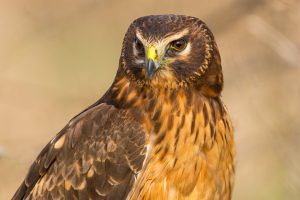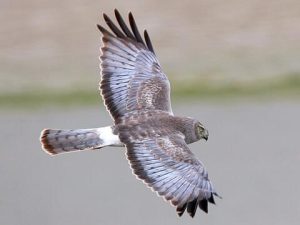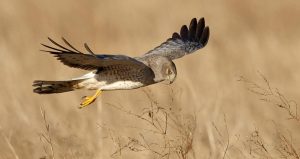Along the expansive marshes where the South River meets the Chesapeake Bay, a distinctive shape glides low over the grass – the northern harrier, one of our most graceful raptors. These unique hawks bring striking male-female dimorphism to our skies: males wear silvery-gray plumage that earns them the nickname “gray ghost,” while females sport rich brown coloring. Both sexes share the species’ most distinctive feature: a white rump patch that flashes like a beacon against their darker feathers.

The Chesapeake region hosts harriers year-round, though our winter population swells significantly as northern birds join our resident hawks from October through March. The extensive marshes near Annapolis become particularly important hunting grounds during these months, when multiple harriers might be seen quartering over the same productive areas, though they maintain hunting territories even in these shared spaces.
What sets harriers apart from our other hawks is their distinctive flight style – a tilting, rocking motion as they cruise just feet above the marsh grass, wings held in a shallow V-shape. From your boat in the South River, you might watch them moving methodically across the marshes, their faces turned downward as they listen and look for prey hiding in the vegetation below. Unlike most hawks, harriers rely heavily on their exceptional hearing to locate prey, their owl-like facial disk collecting and focusing sounds from below. Northern harriers eat a variety of prey, including small mammals, birds, reptiles, amphibians, and insects. Their diet varies by season and location. It’s quite a list! Small mammals voles, mice, ground squirrels, and cotton rats. Small birds like sparrows, larks, pipits, small shorebirds, young waterfowl and galliforms; snakes and lizards; frogs; crayfishes, bats, rabbits, and even adult ducks.

These remarkable birds are among the few raptors that nest directly on the ground. Around the Chesapeake’s shores, breeding pairs select dense patches of high marsh grass or shrubby areas, where females construct substantial nests of sticks and marsh vegetation. This vulnerable nesting strategy makes them particularly dependent on undisturbed coastal marshlands, highlighting the importance of preserving these threatened habitats along the South River and broader Bay.
While not strictly flocking birds, winter concentrations of harriers can create spectacular viewing opportunities around Annapolis waters. Dawn and dusk are particularly active times, when multiple birds might be seen working the same marsh system. Females and juveniles (both brown in color) typically outnumber the more dramatic-looking males, especially in winter, making any sighting of a “gray ghost” particularly memorable.
Their hunting behavior provides endless entertainment for waterfront observers. Unlike the power-diving ospreys or the forest-threading accipiters, harriers employ a patient, methodical approach. They use the slightest breeze to stay aloft, barely seeming to move their wings as they drift back and forth across the marshes. When prey is spotted, they drop directly onto it with surprising accuracy, their long legs adapted for reaching down through tall grass to grab hidden prey.
Spring brings elaborate courtship displays to the skies over the South River’s marshes. Males perform spectacular “sky dancing” routines, climbing high before diving and rolling, sometimes passing food to females in mid-air. These aerial ballets, accompanied by distinctive calling, add another dimension to early spring days along the Bay’s edges.

For visitors exploring the Chesapeake by boat, the best harrier viewing occurs along marsh edges during lower tides, when these birds concentrate their hunting over exposed areas. Their low flight pattern and distinctive white rump patch make them easy to identify even at considerable distances, while their hunting technique allows for extended observation periods as they systematically work the shoreline.
So on your next cruise along the South River or broader Chesapeake Bay, scan the marsh edges for these distinctive hunters. Whether you’re watching a gray ghost male drifting through the evening light, or observing a female dropping precisely onto hidden prey, you’re witnessing one of our most specialized aerial predators at work. In their dependence on healthy coastal marshes, harriers remind us that preserving these vital ecosystems isn’t just about the landscape – it’s about maintaining the intricate web of life that makes the Chesapeake Bay region so extraordinary.
